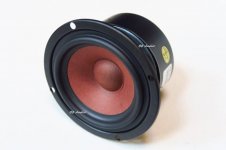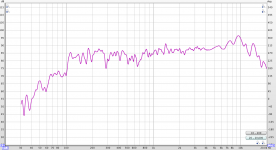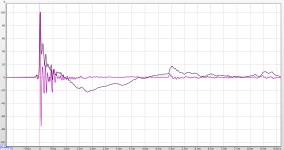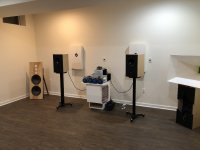Dayton drivers IME are considerably more expensive here in Europe and approach the not so budget territory.
Probably true, unless you have a friend who frequents both sides of the pond and can hand-carry for you...
New Class AB amp powering the FAST speakers. Aspen DELTIC 60-80wrms. Great sounding and very engaging.
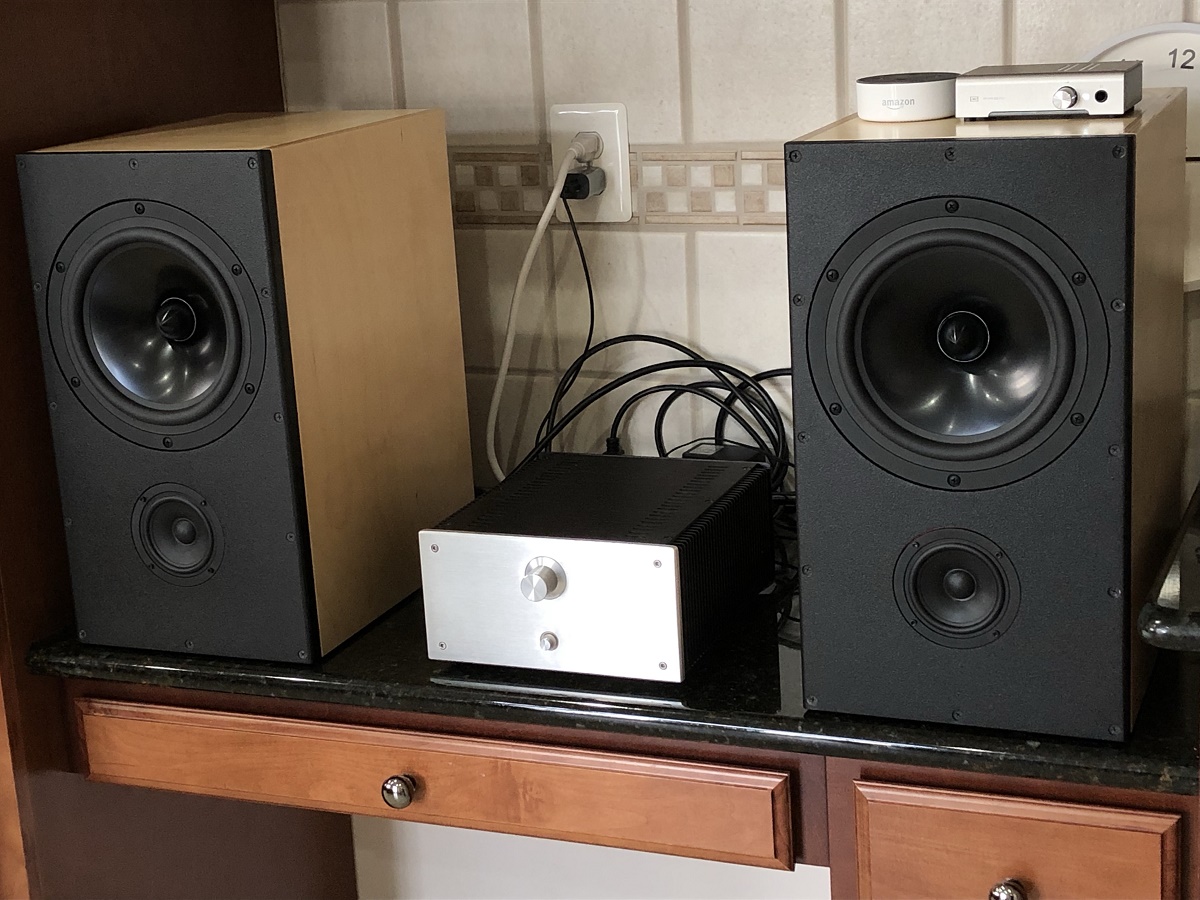
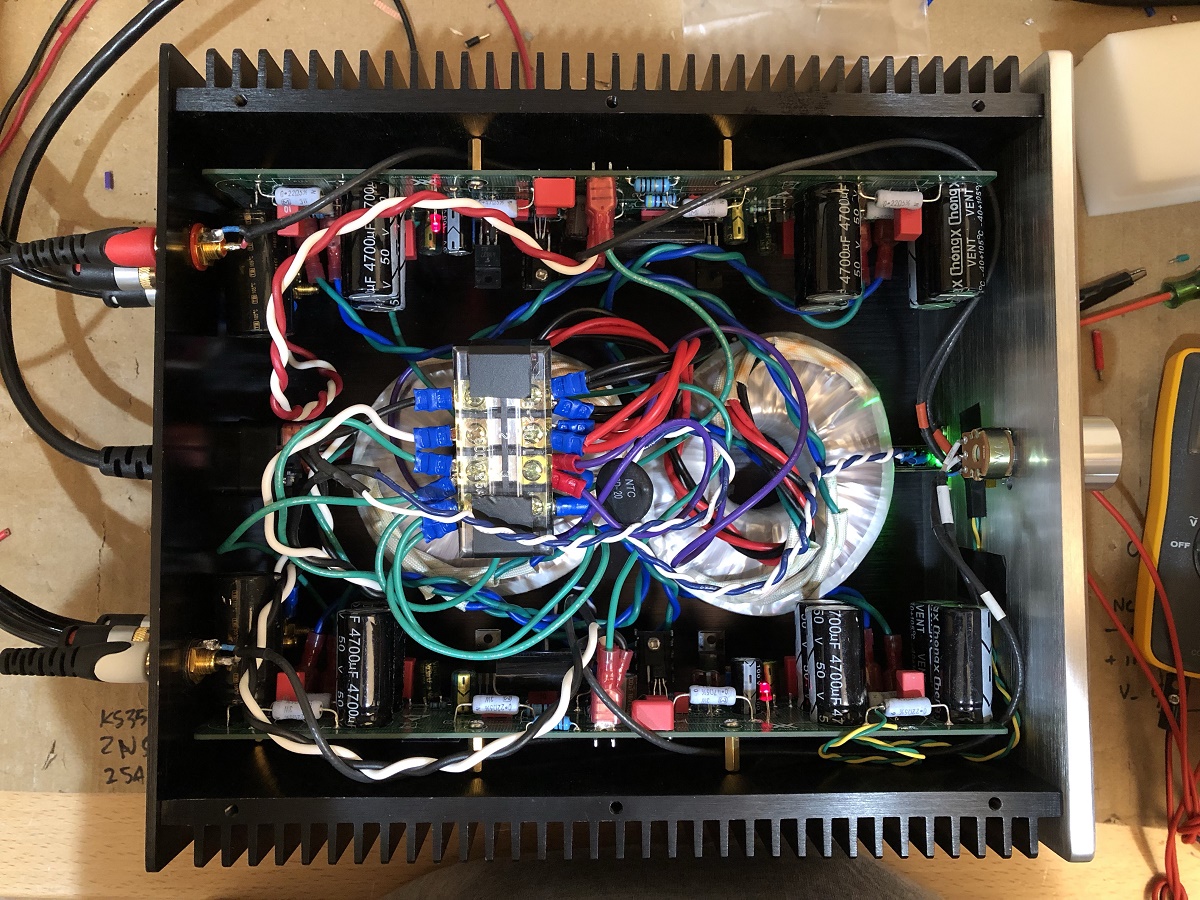
i beleive there is no specific specs for the egg crate foam. below one should be fine i guess.
NRC > 0.90
MMT Acoustix(R) Egg Tray Soundproofing Acoustic Foam Studio, 6'x3' (1 Panel): Amazon.in: Musical Instruments
NRC > 0.90
MMT Acoustix(R) Egg Tray Soundproofing Acoustic Foam Studio, 6'x3' (1 Panel): Amazon.in: Musical Instruments
An alternative are mattress eggcrate foam liner pads. Lots of area here and may be much more economical for many speakers to come.
Amazon.com: Vaunn Medical Egg Crate Convoluted Foam Mattress Pad - 3" Thick EggCrate Mattress Topper (Hospital Bed Twin Size) - Made in USA: Health & Personal Care
Amazon.com: Vaunn Medical Egg Crate Convoluted Foam Mattress Pad - 3" Thick EggCrate Mattress Topper (Hospital Bed Twin Size) - Made in USA: Health & Personal Care
Would a RS225P also work?
R.
I'm following this thread for months and I really like to build these speakers. The dayton's are a bit hard to get and now these RS225P-8 came for sale and I immediately put my short question on the forum. So I thought to be more elaborate a second time around...
I really would like to know if much search and wait a bit longer or that I should buy these.
R.
...The dayton's are a bit hard to get...
In € they ask from 74,90 to 79,95 in below three links and they also seem in stock.
France: DAYTON AUDIO RS225-8 Reference Speaker Driver Woofer 80W 8 Ohm 87dB 28Hz - 2400Hz O 22cm - Audiophonics
Germany: RS225-8 | Speakers Intertechnik - Shop - Shop
Netherland: Dayton Audio RS225-8 8" Reference Woofer - SoundImports
Thanks, Brytt
I'm on a tight budget so I would like to score them "second hand" for example: I can get the RS225P for €90 for the pair.... But I'm itching to build them so maybe I sound dig a bit deeper in my budget...
I'm on a tight budget so I would like to score them "second hand" for example: I can get the RS225P for €90 for the pair.... But I'm itching to build them so maybe I sound dig a bit deeper in my budget...
I know the urge to buy something on sale. However, in this application I cannot recommend it. Please look at the frequency response charts you will see the paper version has a dip at 1kHz and first breakup near 3k, whereas the aluminum is flat through 1k and first breakup closer to 5k-7k. With a 1st order XO, smooth wide bandwidth is of great importance. The paper cone driver will require a new XO to be developed and I can’t say it will be better. But if you are willing to try to make your own XO based on measurements it could be done.
I'm always on the lookout to find a diamond in the rough over here. Found three I thought looked alright, but as usual, no data whatsoever, except the size and how much they weight.
In the past, with the other drivers I tried, there was a trend of a major breakup between 8kHz and 12kHz.
Got one already, waiting for 2 more.
This one is a small 3", paper cone. The cone is quite rigid, and has a cute copper color.
Put it in DATS, and got a big surprise... this thing has a Qtc of 1.4. Yikes!
DATS told me its resonant frequency is 163Hz. So, I was a bit surprised when I ran a REW sweep and measured the driver to go all the way down to 100Hz. 😱
No surprise to see a break up around 9kHz though.
Impulse looked alright, and overall, not a bad little driver for $9.
So, I added a small notch between 7 and 11kHz to reduce the breakup, and it's really alright... and impressive to go so low.
I decided to have fun, and put an EQ on it, +8db at 60Hz... and it handled it. Of course, distortion went up, but no crazy sounds of drivers falling apart. Pretty cool!
I might make a cheap version of the 10F+RS225 with it.
In the past, with the other drivers I tried, there was a trend of a major breakup between 8kHz and 12kHz.
Got one already, waiting for 2 more.
This one is a small 3", paper cone. The cone is quite rigid, and has a cute copper color.
Put it in DATS, and got a big surprise... this thing has a Qtc of 1.4. Yikes!
DATS told me its resonant frequency is 163Hz. So, I was a bit surprised when I ran a REW sweep and measured the driver to go all the way down to 100Hz. 😱
No surprise to see a break up around 9kHz though.
Impulse looked alright, and overall, not a bad little driver for $9.
So, I added a small notch between 7 and 11kHz to reduce the breakup, and it's really alright... and impressive to go so low.
I decided to have fun, and put an EQ on it, +8db at 60Hz... and it handled it. Of course, distortion went up, but no crazy sounds of drivers falling apart. Pretty cool!
I might make a cheap version of the 10F+RS225 with it.
Attachments
I know the urge to buy something on sale. However, in this application I cannot recommend it. Please look at the frequency response charts you will see the paper version has a dip at 1kHz and first breakup near 3k, whereas the aluminum is flat through 1k and first breakup closer to 5k-7k. With a 1st order XO, smooth wide bandwidth is of great importance. The paper cone driver will require a new XO to be developed and I can’t say it will be better. But if you are willing to try to make your own XO based on measurements it could be done.
That is very clear, thank you! I will go for aluminum version.
R.
Padding Resistors
Just a comment on adjusting the padding - I am wary of altering the L-pad for the widerange. My sense is that changing either value will alter the transfer function, and especially the parallel resistance changes the driver's impedance seen by the circuit. If requiring a a decreased level, adding a resistor before the crossover will alter only the power from the source.
Alternately, both values of the L-pad could be adjusted, maintaining impedance, but I was looking for quick and easy.
In my first implementation I changed the series resistor from 4.7 to 2.35 to accommodate a TC9FD-08, but just went back to 4.7 and notice a possible improvement. Perhaps the crossover region is now more as designated, while the treble range doesn't seem negatively affected.
What do you think, X?
Just a comment on adjusting the padding - I am wary of altering the L-pad for the widerange. My sense is that changing either value will alter the transfer function, and especially the parallel resistance changes the driver's impedance seen by the circuit. If requiring a a decreased level, adding a resistor before the crossover will alter only the power from the source.
Alternately, both values of the L-pad could be adjusted, maintaining impedance, but I was looking for quick and easy.
In my first implementation I changed the series resistor from 4.7 to 2.35 to accommodate a TC9FD-08, but just went back to 4.7 and notice a possible improvement. Perhaps the crossover region is now more as designated, while the treble range doesn't seem negatively affected.
What do you think, X?
The XO slopes are so shallow that I don’t think changing the padding will move it other than due to fact that a higher fullrange level in effect moves the XO over a bit to lower frequency. But not a lot. I think it’s ok to change the series resistor to increase/decrease the mids and highs as you like without negative impact on other aspects. As designed for 10F, the TC9 will need a smaller resistor as it is about 1.5dB less sensitive.
Thanks X. I started second-guessing my initial decrease of R1 when I found a reply you made early this year regarding substituting TC9 for 10f, indicating to increase R2 (very gradually).
When I've been listening to my car stereo with zingy tweeter bouncing around the glass, I start thinking the smooth treble of a Tymphany/Scan Speak widerange lacks some emphasis, but that may well be a deviation from a more "real sound."
When I've been listening to my car stereo with zingy tweeter bouncing around the glass, I start thinking the smooth treble of a Tymphany/Scan Speak widerange lacks some emphasis, but that may well be a deviation from a more "real sound."
I calculated that an L-pad of 4.7/4.7 Ohms as per the current schematic will attenuate an 8 Ohm driver 8-9 dB, while the 10f/8424 should need something like 5 dB. And for the TC9FD-08 we might require 3 dB. That would help explain the rather quiet upper mid/treble I hear with the TC9. So I made a quick change to R1 2.35/R2 16, which should be about 3.5 dB atten, and that brought the high end up nicely. Now sibilants and cymbals have the presence I expect, yet there seems still adequate low end balance.
This has encouraged me to order a pair of 10f/8414 and more resistors for future padding adjustments.
This has encouraged me to order a pair of 10f/8414 and more resistors for future padding adjustments.
Music is finally playing again in the Speakerlab, post flood. Flooring has been done for some time but finally got around to sweeping, mopping, and bring all the gear back downstairs. The 10F/RS225 FAST are playing on Aksa's new Deltic Class AB (small aluminum case on top). Looking for my subwoofer speaker cable still. No carpeting means quite a bit more reverberation - will have to get some area rugs and wall sound treatment panels. Sounds good though. Source is actually Bluetooth from iPhone, then Aksa Lender preamp, then Deltic 65w Class AB to speakers.
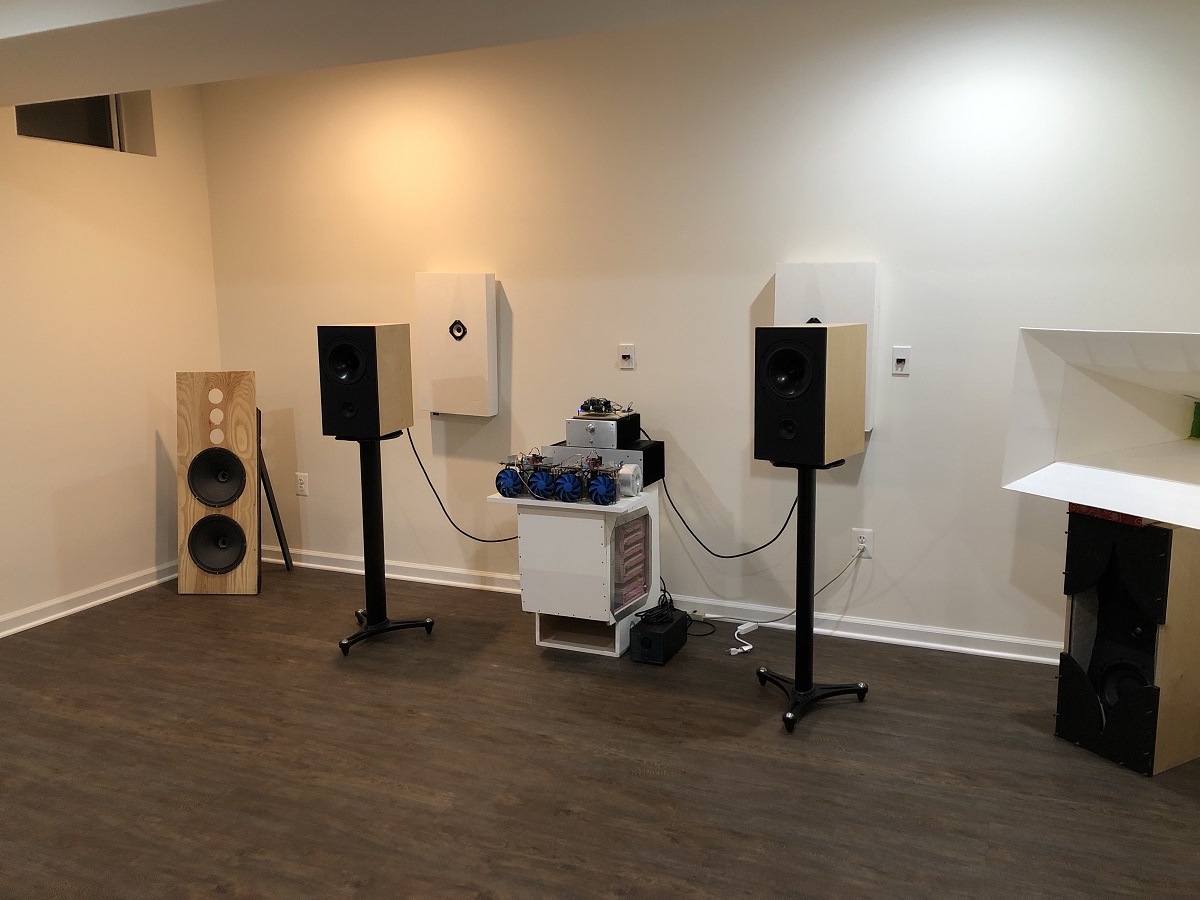
Attachments
Music is finally playing again in the Speakerlab...
Looks very clean but little bit reverbant 🙂 enjoy and hope flood will never happen there again.
...I start thinking the smooth treble of a Tymphany/Scan Speak widerange lacks some emphasis...
Can this help get a feel when dialing in system and XO network components, its a visual model of hor/ver syntetic polars (textbook smooth) for 3 inch plus 8 inch pistons summed with a 1st order network at 800Hz and a system pass band covering 52Hz-18kHz with a center to center distance set to 220mm.
Mid/tweeter is centered on baffle so horizontal polar is symetrical and the missing power response around XO point area is because 8 inch piston start to beam off axis and need XO point down at 200-300Hz area or below to get cleaned up and at HF end a 3 inch piston starts its beam about 3,5kHz area, vertical polar is non symetrical (tilted) as effect of using odd order filter combined acosutic centers have some distance and symptom cover a relative wide bandwidth because slope is less steep than most, it looks when mid/tweeter is below woofer then cieling area is hotter than floor.
Attachments
Last edited:
I have started working on these enclosures, & just finished the hardest part first. The Dagger, Internal volume is 1.1 ltrs.
Sadik
An externally hosted image should be here but it was not working when we last tested it.
An externally hosted image should be here but it was not working when we last tested it.
An externally hosted image should be here but it was not working when we last tested it.
Sadik
- Home
- Loudspeakers
- Full Range
- 10F/8424 & RS225-8 FAST / WAW Ref Monitor
